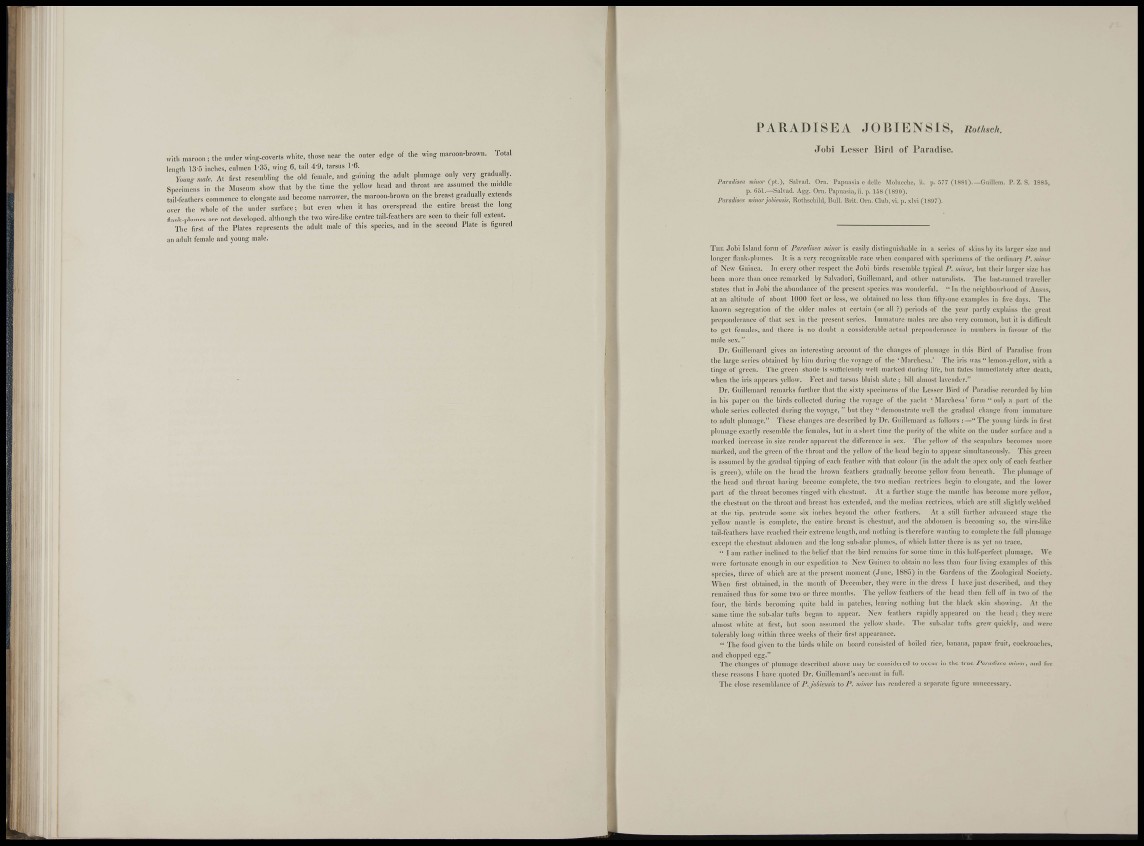
»•Itl, mnroon ; the under wing-coverts white, tlmse near tl.e outer edge of the wing maroon-brown. Total
length i;i-5 inches, enln.en 1-35, wing 6, tail 4'9, tarsus 1-6.
Youno- male At first resembling the old female, and gaining the adult plumage only very gradually.
Specimens in the Museum show that by the time the yellow head and throat are assumed the middle
tail-feathers commence to elongate a,id become narrower, the maroon-brown on the hr.iast gradually extends
over the whole of the under surface; but even when it has overspread the entire breast the long
flank-phnnes are not developed, although the two wire-like centre tail-feathers are seen to their full extent.
The first of the Plates represents the adult male of this species, and in the second Plate is figured
an adult female and young male.
i-nul;
lis
L |ii| I
l l ' ' '
i;
•-e.. Ifc a :
PARADISEA JOBIENSIS, wMsch.
Jobi Lesser 15inl of Paradise.
Paradisea minar ([itj, Salvad. Orn. Papuasia e delle Molucchc, ii. p. r)?? (1S81). —Guillcm. P. Z, S. 1885,
p. 851.—Salvad. Agg. Orn. Papunshi, ii. p. 158 (ISilO).
Paradisea minor jobiensis, Rotliscliild, Ball. Brit. Orn. Club, vi. p. xlvi (1897).
T he Jobi Island form of Paradlmi minor is easily distinguishable in a series of shins by its larger size aiitl
longer flank-]iliiincs. It is a very recognizable raee when eompared with specimens of the ordinary I', minor
of New Guinea. In every other res]iect the Jobi birds resemble typical /' . minor, but their larger size has
been more than onee remarked by Salvadori, Guillemard, and other naturalists. 'I'lie last-named traveller
states that in Job! the abundance of the present species was wonderful. " In ihe neighboiirhoad of Ansns,
at an altitude of about 1000 feet or less, we obtained no less than fifty-one examples in five days. The
known segregation of the older males at certain (or all ?) ¡>erlods of the year partly explains the great
preponderance of that sex in the present series. Ininiature males are also very common, but it is diflicult
to get females, and there is no doubt a considerable actual preponderance in numbers in favour of the
male sex. "
Dr. Guillemard gives an interesting account of the changes of plumage in this liird of Paradise from
the large series obtained by him during the voyage of the ' Mnrchesa.' The iris was " lemon-yellow, with a
tinge of green. The green shade is snliiclently well marked during life, but fades immediately after death,
when the iris appears yellow. Feet and tarsus bluish slate ; bill almost lavender."
Dr. Guillemard remarks further that the sixty specimens of the Lesser Hird (if Paradise recorded by him
in his paper on the birds collected during the voyage of the yacht 'Marchesa' form "only a part of the
whole series collected during the voyage," but they "demonstrate well the gradual change from immature
to adult jilumage." These changes are described by Dr. Guillemard as follows :—" The young birds in first
jdiiinage exactly resemble the females, but in a short time the parity of the white on the under surface and a
marked increase in size render ajiparent the diflerence in sex. The yellow of the scapulars becomes more
marked, and the green of the throat and the yellow of the head begin to ajipear simultaneously. This green
is assumed by the gradual tipjiing of each feather with that colour (in the adult the ajiex only of each feather
is green), while on tlie head the brown feathers gradually become yellow from beneath. The plumage of
the head and throat having become complete, the two median rectriees begin to elongate, and the lower
part of the throat becomes tinged with clicstnut. At a further stage the mantle has become more yellow,
the chestnut on the throat and breast has extended, and the median reetrices, which are still slightly webbed
at the tip, protrude some six inches beyond the other feathers. At a still further advanced stage the
yellow nianlle is complete, the entire breast is chestnut, anil the abdomen is becoming so, the wire-like
tail-feathers have reached their extreme length, and nothing is therefore wanting to complete the full plumage
exccpt the chestnut abdomen and the long snli-ahir plumes, of which hitter there is as yet no trace.
" I am rather inclined to the belief that the bird remains for some time in this half-perfect plumage. We
were fortunate enough in our expedition to New Guinea to obtain no less than four living examples of this
species, three of which are at the present moment (June, 1885) in the Gardens of the Zoological Society.
When first obtained, in the month of December, they were in the dress I have just described, and they
remained thus for some two or three months. The yellow feathers of the head then fell olf in two of the
four, the birds becoming quite bald in ]iatches, leaving nothing but the black skin showing. .4t the
same time the sub-alar tufts began to ap|)ear. New feathers rapidly appeared on the heail; they were
almost white at first, but soon assumed the yellow shade. The suh-alar tufts grew quickly, and were
tolerably long within three weeks of their first appearance.
" The food given to the birds while on hoard consisted of boiled rice, banana, papaw fruit, cockroaches,
and chopped egg."
The changes of iibimage described above may be considered to occur in the true Paradisca minor, and for
these reasons I have quoted Dr. Guillemard's account in full.
The close resembhinee of P. jobiensis to P. minor has rendered a separate figure unnecessary.